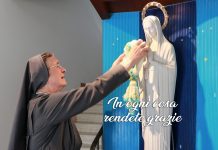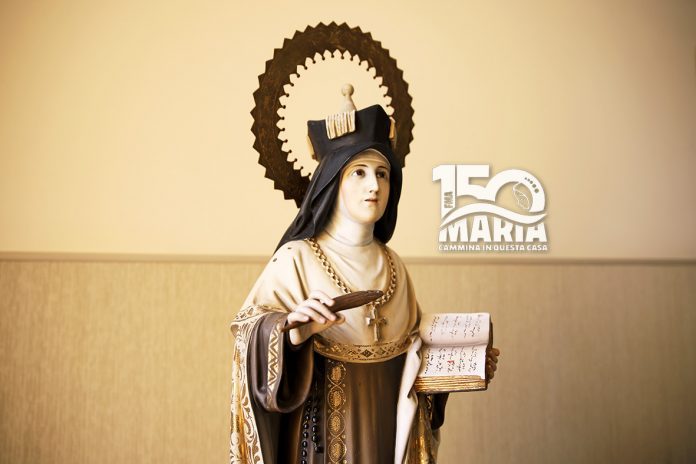Rome (Italy). On 15 October 2022, the Feast of St. Teresa of Avila is celebrated, recognized and desired by St. John Bosco as Patron of the Institute of the Daughters of Mary Help of Christians. In the context of the 150th anniversary of the Institute, celebrating her means recalling her presence.
In the Constitutions of 1885 (XVII, 9) we read, “The Feasts of Saint Joseph, Saint Francis de Sales, and Saint Teresa of Jesus who are the particular patrons of the institute will be celebrated with special devotion and solemnity.” This is an indication that is found up to the current Constitutions, without further specifications. “We will honor in a special way […] St. Francis de Sales, St. Teresa of Jesus whom our Founder gave as Patrons to the Institute” (Const. 45).
Through a careful study of the sources, it can be understood that the spiritual formation of Mary Domenica Mazzarello and the Daughters of the Immaculate Conception (FMI) is for the most part ‘Teresian’. We can speak of a direct influence through the reading of some of the Saint’s works, for example, The life; Path of Perfection, and indirectly, through the mediation of Giuseppe Frassinetti, a great friend and teacher of Fr. Domenico Pestarino. His ascetic works are imbued with the Saint’s doctrine.
Thanks to Frassinetti’s formative action, the Daughters of the Immaculate come to know some parts of the Path of Perfection recalled in the contribution: Our Father of St. Teresa of Jesus. Treatise on Prayer (Parma 1860), which he himself elaborated starting from the spirituality of the Saint of Avila.
In choosing Saint Teresa as Patron, Don Bosco is in continuity with the spiritual tradition of the Daughters of the Immaculate. Moreover, there are many common elements between the ‘Teresian’ spirituality and that of Don Bosco proposed to the Daughters of Mary Help of Christians: spiritual realism; a unitary spirituality in which all aspects of life are unified by love; a simple and affective prayer made from the heart and with the heart; joy as a characterizing element of a healthy and youthful spirituality; harmony between active and contemplative life; filial love for Our Lady.
Two in particular are highlighted:
Joy
In the Constitutions of 1885, Don Bosco added a very significant emphasis in the article concerning the novice formator:
“St. Teresa wanted the nuns to be cheerful, sincere, and open. Therefore, the Novice Mistress will have an eye to make her pupils precisely such, because the Sisters of this character are the most apt to inspire the young girls and people of the century with esteem and love piety and religion” (Rules or Constitutions for the Daughters of Mary Help of Christians aggregated to the Salesian Society, Turin 1885, Tit. IX, 5).
On one of his visits to the community of Alassio, Don Bosco asked the FMA, “Are you all happy?” And he continued, “I recommend holiness, health, science, and joy! Make yourselves all Saint Teresas! Remember that the devil is afraid of happy people. He will tempt you to discourage you for the much work you have (he was speaking in the workroom)” (MB X 648).
Already in the program given to the Daughters of the Immaculate in 1869, Don Bosco proposed some life practices, some simple pedagogical suggestions, and some fundamental elements of Salesian spirituality that were shaping the small group, in line with what was already happening in the House of the Immaculate Conception. Among the elements proposed, we find what concerns the formation of character, “Constant work on one’s nature to form a good, patient, happy character, such as to make virtue lovable and easier to live together” (Cronistoria I, 225).
Joy is seen here in a pedagogical key. In fact, joy, which is first of all the fruit of the Spirit, is contagious. The one who is cheerful transmits peace, light, serenity because happiness comes from a clear conscience. A joyful heart is the normal result of a heart that burns with the love of God, of a poor heart, free from all possessions and entirely inhabited by God, which only expects all good from Him. In this sense, joy is transcendent.
Saint Teresa gives great importance to recreation, a moment in which the sisters meet to share, talk, be together happily, to manifest the Love that inhabits them. It is a pedagogical aspect rich in meaning.
Furthermore, happiness is an element that highlights what God is working in the hearts of His creatures. Feeling joy is a ‘mystical operation.’ It can only come from God, from a motive that is not only earthly, but is the fruit of the Spirit. In this sense, joy is a criterion for a healthy spiritual life.
Our Lady, the true Superior of the community
On the very day of the religious profession of the first eleven FMA, Don Bosco confirmed Mary Domenica Mazzarello in the role of Superior and assured them, “For now she will have the title of vicar, because the true Superior is the Madonna” (Cronistoria I, 308). It seems that Don Bosco’s decisive affirmation on the particular role of the Superior of the house given to Mary Most Holy is to be linked to a Teresian tradition known in the Salesian milieu and probably also in Mornese. In fact, when Saint Teresa had to assume the difficult position of prioress of the monastery of the Incarnation, she placed the image of Mary in her place in the choir. The fact is narrated by Giovanni Bonetti in her biography published in 1882, on the occasion of the third centenary of the death of Teresa of Jesus, and proposed to the FMA of the House of Chieri titled in her name:
“Another way used by Saint Teresa to win the hearts of everyone, and lead them all to God; […] a few days after her arrival at the Incarnation, she ordered the Chapter, that is, the meeting of the sisters; but in the choir, on the Prioress’s chair, she placed the statue of the Madonna with the keys of the monastery in her hand […]. The Saint, taking a stool and sitting near the image of Mary, said: “The office of Prioress, my sisters, is as far from my thoughts as I am far from deserving it. […] Precisely because of this weakness of mine, I do not want to be Prioress of the Monastery, except in name. The true Prioress will be Our Lady who stands before you.” (Giovanni BONETTI, The Rose of Carmel or St. Teresa of Jesus: notes about her life, Turin, SEI 1909, 238-239).
The Teresian inspiration is confirmed in another very significant gesture by Mary Domenica Mazzarello, that of leaving the keys of the house at the foot of the statue of Mary Help of Christians every evening (Cronistoria II 132).
Sr. Elena Massimi, FMA, President of the Italian Association of Liturgical Professors and Experts, proposes the following liturgical texts for the Feast of Saint Teresa of Avila:





















Grazie e bello ricordare e avere presente questi fatti. Grazie di cuore.
Muchas gracias por la liturgia salesiana en honor de Santa Teresa de Jesús, nuestra Patrona. Desde hace años lo deseaba. Al fin llegó el día. Feliz fiesta.